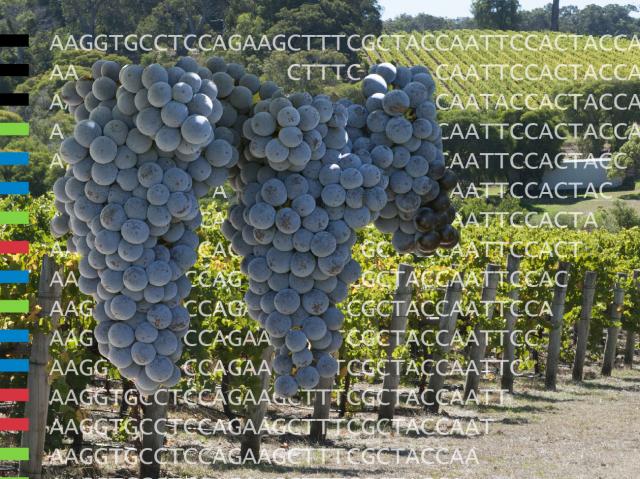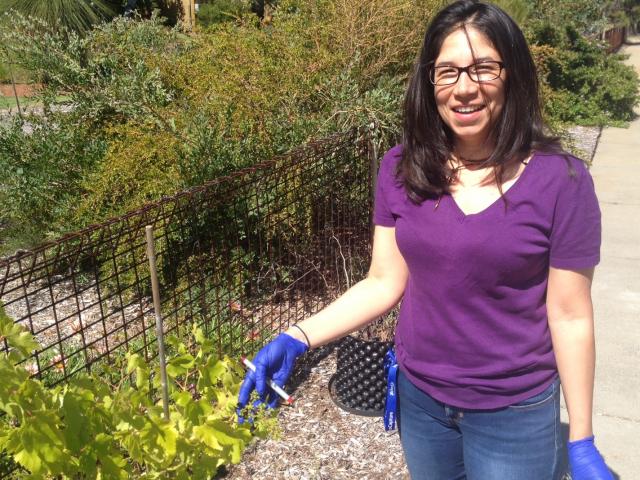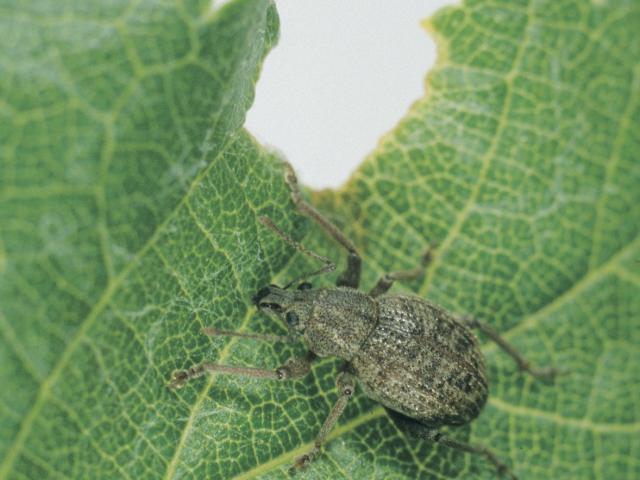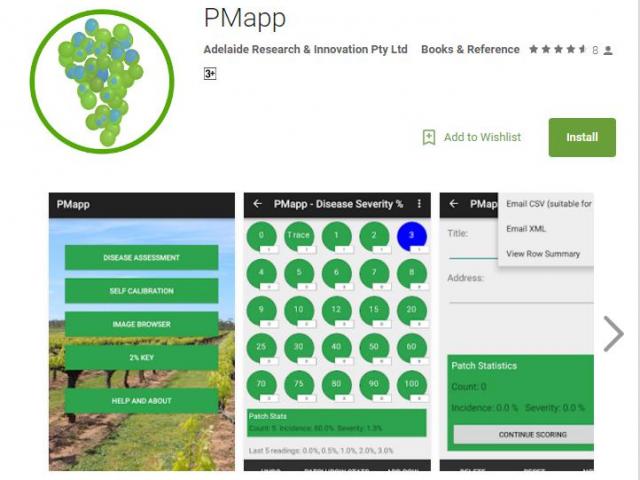Big data, big differences between Cabernet clones
The massive advances in cost-effective state-of-the-art whole genome sequencing (WGS) technologies have provided a unique opportunity to crack the genetic code of agricultural crops such as the grapevine. In this study, researchers are resolving the fingerprints of ten top Australian Cabernet Sauvignon clones in order to identify genetic markers of their identity.
This information will allow researchers in Australia to further explore these spontaneous mutations, and how they relate to variation in berry and wine quality. The information will allow researchers to study the regional effect on expression of clonal quality traits, potentially linking to other research such as the ‘Clones for Climate’ study.
To develop the fingerprints, the team applied genome resequencing of the ten clones, with some replicate vines included (Illumina HiSeq1500, paired-end libraries). The clones were SA125, SA126, CW44, ENTAV338, PDFs, Reynella (mass selection), WA Cape Selection (mass selection) and a selection of ‘Houghton’ clones from two locations.
SA126 was chosen for further replication to ensure that differences identified truly reflected clonal fingerprints. The sequence data were mapped to the Cabernet Sauvignon reference genome, which was only just published this year (Chin et al., 2016). The data represented an approximate 30X depth of sequencing and 90% coverage of the genome. So far so good.
Nevertheless, identifying and validating the fingerprints has proven to be a significant challenge. A number of analytical approaches were applied in order to yield robust fingerprints. Following this pipeline, a total set of 33 362 single-nucleotide polymorphisms (SNPs) were found to discriminate the total set of clones. When researchers compared clones one-to-one, they found they could discriminate each clone using between 1780 to 5100 SNPs. These are considerable differences considering they are all Cabernet Sauvignon!
The data analysis is not yet finished as there are other elements to explore, including the effect of viral infection on the variation in DNA, as well as mobile genetic elements, which may explain some of the larger sequence differences. Importantly, the researchers hope this set of data can be made available to industry and other researchers so that it can be mined for more information as new technologies and understanding emerge.
This research is funded through an Australian Research Council Linkage Project based at the University of Western Australia (UWA), with financial support from the Department of Agriculture and Food WA (DAFWA) and the WA wine industry through the Western Australian Vine Improvement Association (WAVIA), and in-kind contributions from the Yalumba Nursery and the Australian Wine and Research Institute (AWRI).
Further information on this study is available from Patricia Agudelo-Romero and Michael Considine.
Reference
Chin CS, Peluso P, Sedlazek FJ, Nattestad M, Concepcion GT, Clum A, Dunn C, O'Malley R, Figueroa-Balderas R, Morales-Cruz A, Cramer GR, Delledonne M, Luo C, Ecker JR, Cantu D, Rank DR, Schatz MC. 2016, ‘Phased diploid genome assembly with single-molecule real-time sequencing’. Nat Methods, vol. 13(12), pp. 1050-1054. doi: 10.1038/nmeth.4035
US trip gives insight into grape pest and diseases
Andrew Taylor, PhD candidate and Plant Pathologist
As part of my PhD studies on grape downy mildew I recently spent two months visiting grape growing regions in America. The aim of the trip was to pick up downy mildew DNA samples to be able to compare with those found in Australia and to see how the disease is managed in its natural environment.
Downy mildew, along with other significant grape pest and diseases in phylloxera, powdery mildew and black rot, originate from North America. The movement of grape material from America has meant that several of these pests and diseases are now found globally.
Despite being an unusually dry summer in north-eastern America, resulting in less than expected downy infections, the trip was an invaluable learning experience. The difference in management styles for America hybrid production versus those of a European origin was of particular interest.
The WA wine industry is based solely on Vitis vinifera production, vines that are highly susceptible to downy and powdery mildew infection. However, native American Vitis species, for example Vitis labrusca and Vitis aestivalis, are tolerant to powdery and downy mildew and therefore canopy management doesn’t need to be open as it is in WA. Imagine not having to worry about spraying for powdery mildew! Several of the universities in America are undertaking breeding and clonal trials to explore this resistance and the ability to produce quality wines from this material.
Some other destructive grape pests were also on show during my travels and highlighted the importance of our stringent quarantine regulations. Japanese beetle (Popollia japonica) was introduced into America and with the hot dry summer was particularly severe on the grapes during the season. These beetles reduce grape leaves to skeletons and are costly to control.
Phylloxera is an ever present threat to growers in north-eastern America and it was interesting to find that phylloxera leaf galls are rarely seen on Vitis vinifera vines but are quite common on the American vines. Given the presence of phylloxera, all European vines need to be on resistant rootstock.
Crown gall is rarely considered an issue in WA but due to the cold winters in America it is a significant issue for the industry there. If temperatures rapidly drop it is not uncommon to lose entire blocks of vines and those that do survive are susceptible to crown gall problems. At present there is no treatment for crown gall so if infection is too damaging then the vines also need to be replaced.
Results from the downy mildew work will be presented at a later date. The PhD is funded via an Australian Postgraduate Award with top up scholarship from Wines Australia.
The evolution of oxygen during budburst
As part of the efforts to improve the Australian grape industry, researchers at UWA have been studying the factors influencing budburst. A PhD student in Dr Considine’s group, Karlia Meitha, studied the physiological and genetic regulation of buds at the earlier stages of burst in relation to their tissue oxygen status and light perception.
The timing of budburst is determined by a balance of external environmental cues and internal processes, and is a major determinant of other events such as flowering during the growing season. The management of budburst is often problematic in the areas with warmer winter and abnormal seasons.
The expensive and laborious application of phytotoxic chemicals such as hydrogen cyanamide is commonly performed to force budburst. Thus, the objective of her research was to improve the knowledge in biological processes of the buds responding to seasonal cues. This knowledge will then enable us to develop a more environmentally friendly method of budburst management.
The conditions of light and temperature have long been proposed as the main environmental cues that trigger the onset and release of bud dormancy. However, the signaling events during these stages are still unclear, as are the direct consequences of abnormal seasonality, such as those forecast in climate change scenarios.
Mrs Meitha’s research found that tissue oxygen status is important in curating stress-dependent processes in buds during the initiation of burst. Her results showed that the condition of tissue oxygen in the sensitive meristem area of the buds were very low (hypoxic) and gradually increased as the buds progressed to burst.
This gradual increase of tissue oxygen status is complemented by the shift of reactive oxygen species (ROS) within the bud, implicating oxygen and ROS in key developmental functions. These data were supported by gene regulation, which highlighted a prominent role for the chloroplast, even though the buds remained tightly enclosed and apparently protected from direct light.
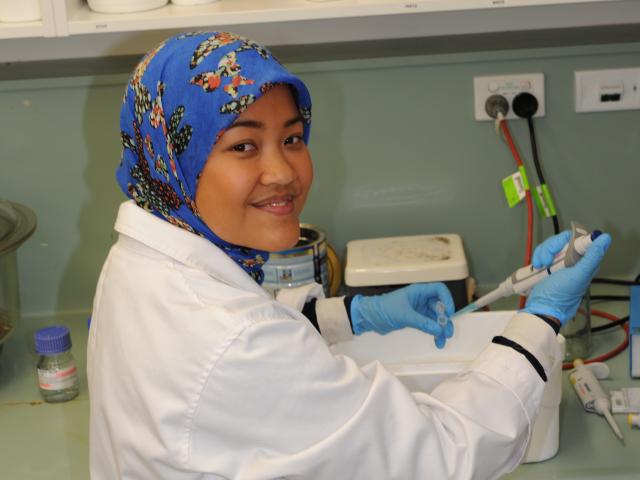
Mrs Meitha’s research was submitted for publication and her PhD thesis is currently under examination. Her work provides a platform for other current and future students to more fully explore the dynamics of bud activity throughout the year and in conditions of climate stress.
This research was funded by the Australian Research Council (LP0990355, DP150103211), with financial support from DAFWA. Mrs Meitha’s scholarship was supported by an Australia Award Scholarship and a Wine Australia travel grant.
Further information on this study is available from Karlia Meitha and Michael Considine.
Insects and mites
Garden weevil soft controls demonstrations
A number of vignerons in the Margaret River and Great Southern wine regions are investigating different soft options to determine whether the reliance on broad spectrum insecticides can be reduced.
Some of these options were investigated in small lot work when a research project on garden weevil was undertaken some years ago. This new work involves the same products plus some new ones on a larger scale as listed below.
- Soil applied pathogenic fungi - against larvae
- Soil applied molasses - improving vine’s natural tolerance to pests
- Dacron bands - plain or soaked in hot chilli to deter climbing adult weevils
- Surround and potassium silicate foliar spray to deter feeding by adult weevils
Results of the investigations will be presented at workshops in both regions after vintage in 2017.
Apple looper – we need insects
We have recently discovered experts working on pheromone development at UWA. They have shown interest in assisting the WA wine industry by working on the development of a pheromone to help with monitoring apple looper.
Please contact DAFWA if you experience an infestation of apple looper. Details of apple looper are available on the DAFWA website.
For more information contact Stewart Learmonth or Helen Collie at the DAFWA Manjimup Horticultural Research Institute.
Linking social media to biosecurity surveillance
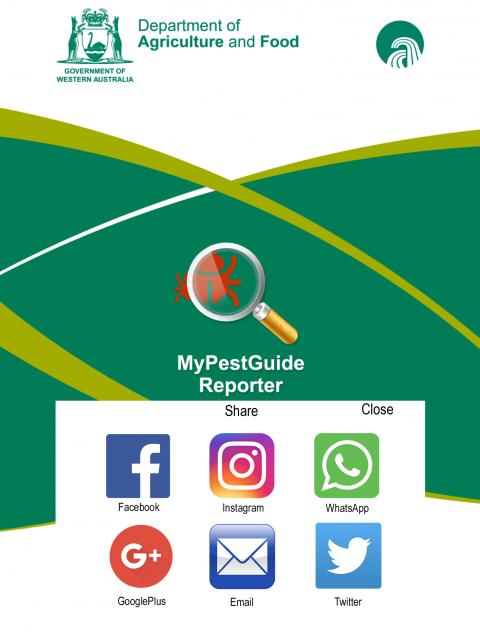
MyPestGuide™ Reporter is an easy-to-use reporting tool, designed to get the community involved with pest surveillance. When combined with MyPestGuide™ Grapes app, it provides a powerful identification and reporting tool for both hobby and commercial vineyards.
To increase community uptake and awareness of the apps, DAFWA has released an updated version of MyPestGuide™ Reporter that allows users to share their reports with friends on social media networks.
MyPestGuide™ reports and images can now be shared to a range of social media platforms including Facebook, Twitter and Instagram. The extra functionality was added in the hopes that it will encourage the public to send in more pest reports and ultimately, get more eyes focussed on pests in WA vineyards.
By incorporating social media platforms, these observations promote community awareness of biosecurity, whilst capturing valuable information within a searchable database that enables DAFWA to better support WA trade and market access and protect the environment.
MyPestGuide™ Reporter is a free reporting and identification tool that allows community members or vineyard workers to take up to four photos of a pest and send the reports directly to DAFWA. Department experts will then identify the pest and send a response back to the reporter’s device.
Every report received by the department, whether it is an exotic pest or not, supports WA vineyard biosecurity and protects market access.
Download MyPestGuide™ apps at Google Play Store and Apple iTunes Store. To see what has been reported, please view the map of shared community reports on the MyPestGuide™ reports web page.
The MyPestGuide™ apps are part of a suite of biosecurity surveillance tools developed and released by DAFWA as part of the Royalties for Regions funded Boosting Biosecurity Defences project.
New in-field powdery mildew assessment app
It is ranked the number one disease for economic impact in Australia and is a constant threat for both crop loss and fruit quality. Despite its prevalence it is a difficult disease to accurately assess in the field and assessments can differ significantly between assessors.
To overcome some of these issues a team of researchers at the University of Adelaide, with support from industry and funding from Wine Australia have developed PMapp. PMapp is a downloadable program for smartphones that allows users to efficiently assess both the incidence and severity of powdery mildew on bunches whilst out in the vineyard.
The application works by matching the assessor’s visual assessment of the surface area of a bunch, infected by powdery mildew and that of pre-installed images with a known level of incidence and severity. To minimise differences between assessors there is a calibration function to allow users to test and improve their accuracy prior to assessments taking place.
PMapp is currently available for download at Apple’s App Store or Google Play.
A new strategy to support WA biosecurity released
Biosecurity incursions have the capacity to increase costs and disrupt export and domestic trade of agricultural, forest, aquaculture and fish products, as well as affecting our unique environment, biodiversity and social amenity.
Effective biosecurity systems help protect Western Australian growers from incursions of pests and diseases that could negatively impact production and access to markets.
The Western Australian Biosecurity Strategy (“the Strategy”) was recently released by the Department of Agriculture and Food, Western Australia (DAFWA) and provides a framework to manage biosecurity issues in Western Australia.
The development of the Strategy was led by government and informed by industry and community. It sets the strategic direction for partnership arrangements to manage biosecurity issues affecting agriculture, fisheries, forests and biodiversity.
The Western Australian Biosecurity Strategy was launched by the Minister for Agriculture and Food Mark Lewis at Upper Reach Winery in the Swan Valley on the 21 November 2016.
Minister Lewis was joined by Minister for Regional Development Terry Redman and Minister for Fisheries Joe Francis.
The Strategy covers the period of 2016-25 and will be reported against annually and reviewed within three years.
The Strategy has been developed as part of the $20 million Boosting Biosecurity Defences project.
To view the Strategy, or to download a copy, please see the WA Biosecurity Strategy webpage.
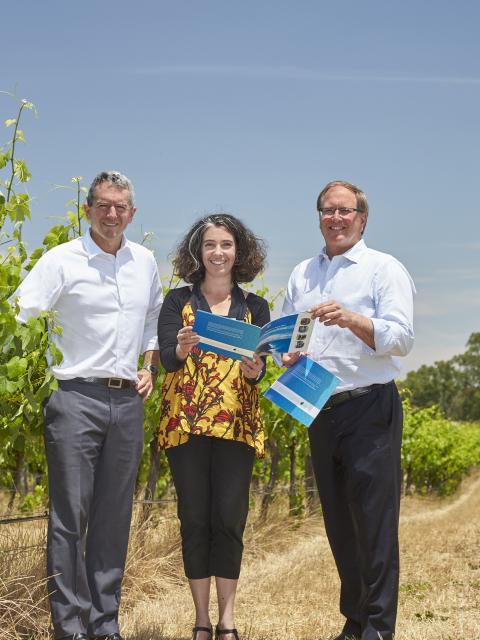
Agricultural Produce Commission update
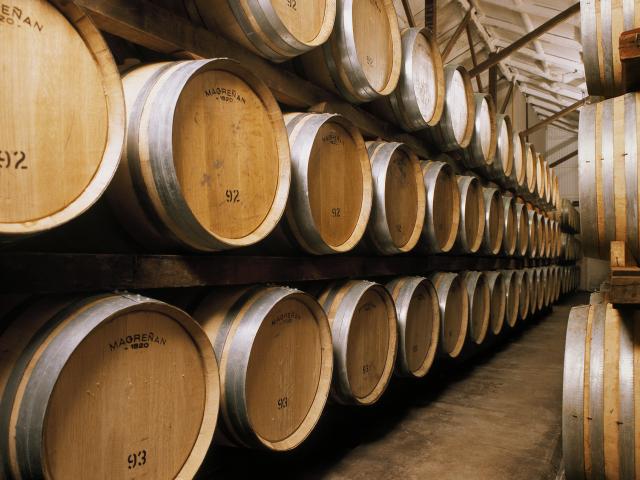
The industry has come to this position through an extensive consultation process which started in July 2013 and concluded in December 2015 with industry consensus support for a wine industry APC. The timeline for the process is outlined below.
- July – August 2013: Industry strategic review workshops in Mt Barker, Margaret River and Swan Valley. Polling of attendees established significant majority support for an industry wide secure funding model for industry development and representation.
- August – November 2013: Industry Reference Group ratifies WA Wine Industry Strategic Plan 2014-24. Strategic Focus 1 determined that Wines of WA and Regional Associations should investigate an industry wide secure funding model to support industry development and representation. The APC was identified as the most suitable model for this purpose.
- July 2014 – August 2015: Wines of WA and Regional Associations facilitate industry consultation. A model for industry development and representation under an APC is developed and formally ratified by Regional Associations.
- September 2015 – November 2015: Wines of WA and Regional Associations provide information on a Wine Producers’ Committee for producers including: Regional workshops, one on one consultations, information packs posted to all producers and information available on Wines of WA website. Additionally, advertisements were placed in all regional newspapers where producers were located
- December 2015 – Postal poll of industry is conducted. Polling pack sent to all producers who would pay the Fee for Service (FFS). In total, 494 were sent to producers. The poll result provided significant industry support for the establishment of a Wine Industry APC.
The Committee works with WA Regional Associations and the State Association to provide services on behalf of WA Wine Producers. These services are provided through the collection of the FFS charge and collection of this charge (for the 2016 vintage) started in August this year. Under the Agricultural Produce Commission Act 1988 and the Agricultural Produce (Wine Industry) Regulations 2016 payment of the wine FFS charge is compulsory.
The APC Chairman, Dr William Ryan said that “The new wine committee structure will provide ongoing funding for both state-wide matters and each of the regional wine associations. This is another example of the APC structure providing a good framework by which industries can fund their activities on a sustainable basis.”
The WA wine industry requires a united, sustainable and influential voice and the establishment of the APC Wine Committee, working through the State and Regional Wine Associations provides a secure funding model for this to be achieved. The ability to implement longer term programs to bring about positive change and growth for WA Wine Producers will result in a more prosperous industry.
The Chairperson of the Committee; Mr Jeff Burch of Howard Park and MadFish Wines said “We have an exciting future for wine in Western Australia, where we have a wonderful product, produced in a clean green environment that is increasingly appreciated globally.
This development will enable the WA Wine Industry to work together to take that message to the global market place. Every bottle of WA Wine sold outside of WA is a post card from Western Australia.”
With each GI location and industry Association identifying different priorities for this first year of operation the rate and manner of the charge has varied between GI locations. Some of the services which will be provided in GI locations are: support for regional wine events, regional brand development (including websites) and development of regional marketing or business plans. State services which will be provided are market development and consumer interaction, innovation, research and biosecurity and advocacy on legislation and regulation issues that affect wine producers.
Associations will communicate with producers to identify their priorities for services which will be provided in coming years, but producers can also contact either the Associations themselves or the APC to propose services which might be of benefit to the industry. The APC is currently calling for project proposals for all APC producers committees with a closing date of 23 December 2016. More information on this call for projects can be found on the APC website at apcwa.org.au or by contacting the Commission on the contact details below.
Any wine producer who has not paid the FFS charge for the 2016 year and is not sure of how to proceed should contact the APC on +61 (0)8 9368 3465 / 3127 or apcadmin@agric.wa.gov.au.
Anyone wanting to know more about the operations of the Committee can contact the Committee chairperson, Jeff Burch on +61 (0)418 384 558 or the Commission directly through Ingrid Smith, +61 (0)8 9368 3127.
Future events
Alternative variety field walk
Approximately 80% of WA’s wine grape production comprises of five varietals. Reliance on a small collection of varietals presents certain challenges, especially in terms of adapting to a changing climate and market trends.
Varietal selection is one tool available to address these challenges.
DAFWA and collaborating partners invites you to inspect the performance of 22 varieties and discuss their suitability to WA growing conditions.
The format of the field walk is an “open house” between 10am and 1pm. Drop in at any time during this period and make your own way through the block inspecting the performance of the vines at your leisure. Information on the background and characteristics of each of the varieties will also be available.
When: 10.00am – 1.00pm Thursday 12 January 2017
Where: WA College of Agriculture – Harvey, Mornington Rd, Wokalup WA 6221
Cost: Free to WA wine and grape producers
RSVP: Please register your interest in attending by contacting Richard Fennessy, +61 (0)8 9780 6219.
Evaluation of winemaking treatments in Australian Pinot Noir
This workshop showcases how current winemaking practices can influence final wine style. Eleven different wines have been made from the same batch of Pinot Noir grapes using a range of different harvest dates and winemaking techniques.
Explore and compare the stylistic and compositional differences when one variable is changed at a time.
When: 9.30am – 11.00am Monday 23 January 2017
Where: Arts House, West Cape Howe Wines, 14923 Muir Highway, Mount Barker WA 6324
Cost: $22.00 inclusive of GST
RSVP: To book and for more information contact John Gates, Great Southern Wine Producers Association, info@greatsouthernwine.asn.au or +61 (0) 407 987 889.
Cabernet Hang-time Forum
You are invited to participate in the Margaret River Cabernet Hang-Time Forum to hear the latest research outcomes and opinions on how ‘Cabernet hang-times’ impact on fruit quality, wine quality and profitability from local, national and international experts.
The program will cover:
- Impact of hang-time on Cabernet and Merlot from a Californian and Washington State perspective
- Influence of hang-time on phenolics
- Pinpointing optimum ripeness, a Margaret River case study
- A winemakers view on hang-time
- Plus more…
Where: Curtin University – Margaret River campus
When: 9.00am – 2.00pm Tuesday 24 January 2017
Cost: free, funded by the Wine Australia, Regional Program
RSVP: Email Jodie from Wines of WA with your name(s) or telephone/text +61 (0)466 744 957 Keith Pekin with your details.
Further information about the forum is available on the Wines of WA events database.

